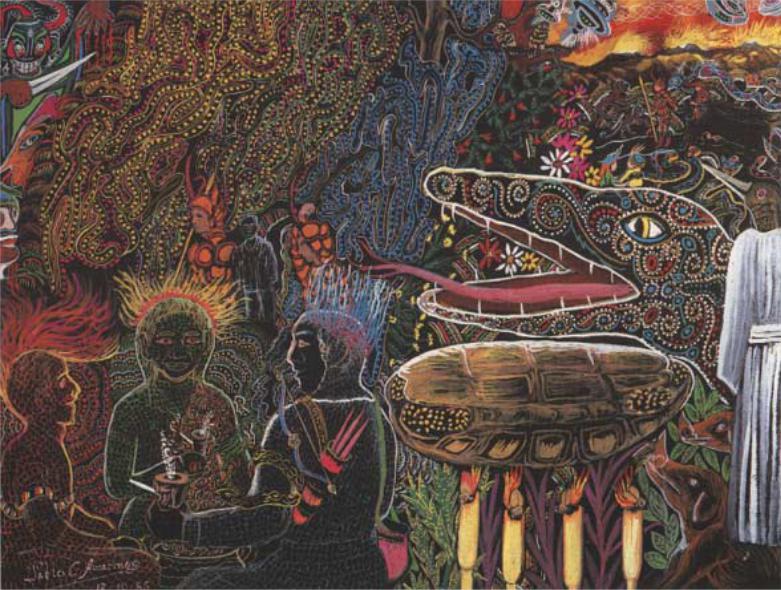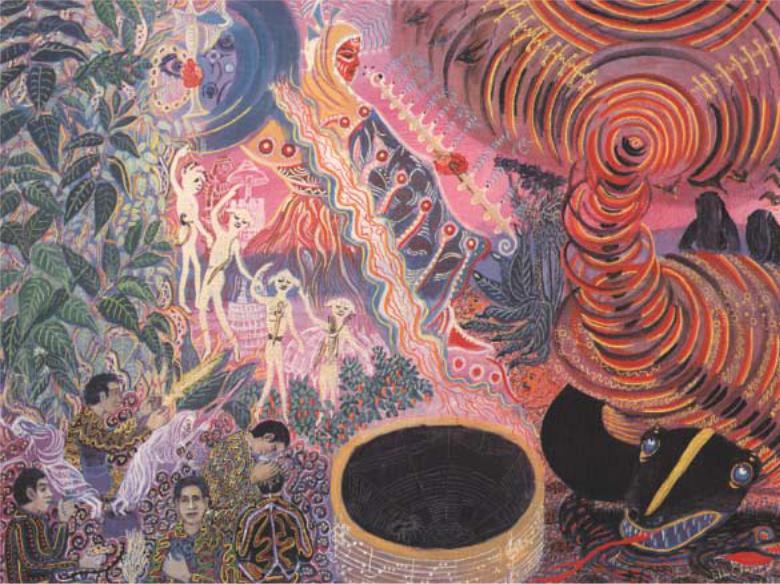
- •Vision 2
- •Vision 3
- •Vision 4
- •Vision 5
- •Vision 6
- •Vision 7
- •Vision 8
- •Vision 9
- •Vision 10
- •Vision 11
- •Vision 12
- •Vision 13
- •Vision 15
- •Vision 16
- •Vision 18
- •Vision 19
- •Vision 20
- •Vision 21
- •Vision 23
- •Vision 24
- •Vision 25
- •Vision 26
- •Vision 27
- •Vision 29
- •Vision 30
- •Vision 31
- •Vision 32
- •Vision 33
- •Vision 34
- •Vision 35
- •Vision 36
- •Vision 37
- •Vision 38
- •Vision 39
- •Vision 44
- •Vision 45
- •Vision 46
- •Vision 47
- •Vision 48
- •Vision 49

evening. Cam uri is a kind of small fruit of orange color which the vegetalistas keep in their chests, in the way they keep the mann. This is used both for healing and causing harm, depending on the intentions of the vegetalista.
VISION 46
SEPULTURA TONDURI
This vision is called sepultura tonduri [Spanish sepultura = grave, funeral], which
is a very sad and frightening icaro, sung by a sorcerer to kill a person or his enemy. We see here three vegetalistas who gathered to take the purge. The man on the extreme left, dressed in clothing with steel scales, is a sorcerer who never heals, only kills. That is why the fire coming out of his head is very hot and his aura is red, as if it were dyed with blood. Around his arm he carries a nacanaca snake [Micrurus sp.], and all his knowledge can be seen in the yellowand violetcoloured figures on his head.The other man, dressed in green, is a witch and a sorcerer. He is a witch because he casts his spells so as to imprison a person and do with him as he pleases. He is a sorcerer because he casts a spell to kill the person he chooses.The one dressed in light blue is a perfect master who only heals. His aura is light blue and he shows his knowledge with the light blue and white colours. He carries the virote huani, which consists of glass arrows and a cumaceba [Swartzia sp.] bow for use in difficult situations. But if he uses this weapon, he then becomes a criminal.
Of the strange beings that appear on the extreme left, the one on the top belongs to the green man, and the other two lower down belong to the witch and the red sorcerer. Two soldiers take from his bed the soul of a muraya, and they make him go to the red sorcerer singing the icaro sepultura tonduri. The latter calls the Sachamama so that when he swallows the muraya, the Sachamama will be his coffin, and he calls the moteb-mama [motelo = the tortoise Geochelone denticulata] who represents the table where people will hold the wake. The mushrooms represent the candles, and the ayanahuis [fireflies] the flames of the candles. The alipa-cuchis [alipa earth, kuchi pig], with their sharp snouts, represent those that will dig his grave, and the bird in white clothes represents his shroud. This bird, that flies shrieking in the night, is called the rompe-mortaja. The small flowers serve as a wreath for the dead, while the big ones will grow on his grave. In a tree in the background you can see two birds called huancahui [Herpetotheres cachinnans]
whose singing represents the relatives who shall weep. But this muraya is stronger than the three vegetalistas. We see to the far right how he summons his powers, the nina-rumis volcanoes [nina = fire, rumis = stone], which are mighty with their lava flows and earthquakes and their large spaceships, which come to attack making circles with laser nets, ready to catch in their traps everything the sorcerer uses. The witch in turn sends out his genies, the sinchi-cobras and other snakes, the monkeys called suniquiros [long teeth], and the powerful sarara [Anhinga anhinga] who go to meet the flying snakes of the muraya.This battle occurs in the muraya's dreams; everything occurs while he rests. He will wake up safe and sound because his genies will defend him.

VISION 47
ELECTROMAGNETISM OF THE YANAYAKUMAMA
This is a fight between a witch sumiruna [a witch that can go under the waters] and a very strong vegetalista called in Quechua Sinchicunan-muraya. With his wisdom this medicine man can open a sort of well in the ground. The well is called in Quechua alipa-shimi [earth's mouth]. A big spider [atun-machipuri] dwells here which by touching the threads of its web produces melodies that captivate the yana-
yakumama [black boa, mother of the waters].
The witches use this black boa as a battleship to attack their victims. It has a white stripe on its forehead, a sign that distinguishes it from all the other black boas. It lives in the depths of the black-water lakes and in lakes closed by the aquatic plant piripiri. It comes up to take sun-baths in mid-day, when the sun is fullest, to fill itself with the solar energies, giving power to its electromagnetism. When the boa is used by the witch, one can see in the vision that a big, electrified tornado rises up from it and liberates flying animals like the sarara, the bird rompe-mortaja, the tibemama, the supay-masho, the yaku-pato, the ayapollito, the suisui-fantasma, the nina-oishco, the tibe negro, and the uma-supay. Behind this boa come the yana-puma runa [black tiger-like people] who cover their faces with their hair. These beings have red eyes, symbolising that they are shitaneros [sorcerers]. They sing the sacrataquina, a maleficent song. They also have big eye-teeth, like curved sabres, and they can become people and animals of different sizes-for example, black water bulls, yana-caballos [black horses] that rise from the water, black yakurunas that ambush their victims on the beaches. Anyone going near them is bewitched by those malevolent beings, as even a mere gaze brings harm.
Behind the head of the boa is the yaku-salamandra, capable of poisoning with its respiration alone. In the back are the puka-puma-runa [people with red tiger's features], guarding an aquatic plant that lives on the bottom of stony brooks with strong current, rising to the surface of the river to eat people. A shitanero calls in his visions a plant called shucui yahuarminta [a blood-sucker] to suck the blood of the Sinchicunan-muraya. The tree behind is called huanuchinampa-caspi [tree that kills]. The Campas Indians call it icabiniri, which means demonic tree.
High in the middle is the great prince Tesael with his magical trumpet. It radiates electrical sounds that absorb the black anacondas' electromagnetism. He
has a hypnotic axe, and its fountain of energy is the strong icaros used by the Sinchicunan-muraya to resist and gain the maleficent icaros of the witch. The icaros of the curandero pull the black boa towards a hole in the ground, where it will be closed with circling discs, charged with radioactivity, which were brought by the great acrobats called yura-pachacama, white souls who take care of the universe. They carry daggers-poisonous arms that cause an unbearable pain.
Behind them rises a priest of a marine town, emerging from the depths of the river. The name of the priest is Turmanshe, which means in archaic Quechua "mes senger of peace." He comes to advise the curandero not to kill the witch that sent the black boa, but to punish him and let him go.
From the ayahuasca pot rise two ayatullo-mamas, each carrying her spear ready to kill, spreading black tingunas that make the enemy nauseous.
The great maestro Sinchicunan-muraya carries a pushaquita, a little pouch, and from there he takes a dagger of fire that flies and chases birds coming from the black boa's electromagnetism, killing them in the air. His disciples help him by chanting an icaro called makacushcan versucun [a song to win]. One disciple is healing a sick person, hurt by the witch with the air of the mother of the water while he was fishing in the lake. He blows him with tobacco and with the power of his medicine that circles around the body of the patient. Among his disciples was I, Pablo Amaringo, who played the schacapa [a rattle made of the leaves of Pariana sp.], singing the icaro sumak versukun of the siren ita Caya [the little mermaid Caya].
